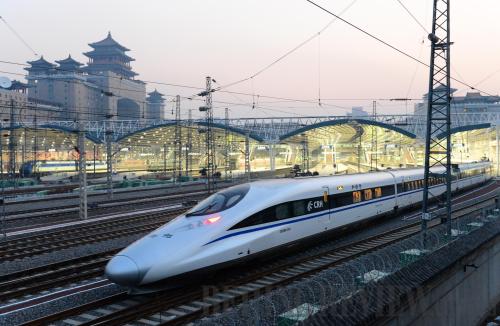|
 |
|
IN OPERATION: A high-speed train enters the Beijing West Railway Station on December 26 (ZHOU GUOQIANG) |
When Zhang Xi, the operator for the G801 high-speed train, made a hand gesture to signal the vehicle's departure from Beijing at precisely 9 a.m., the Beijing-Guangzhou high-speed railway had formally begun its long-awaited inaugural journey.
On December 26, history was made when the world's longest high-speed rail opened to the public. The line runs from the national capital Beijing down to the southern metropolis of Guangzhou, capital of Guangdong Province, covering a total of 2,298 km.
The high-speed trains run at a maximum speed of 300 km/h, although they can reach up to 350 km/h, cutting the distance between two of China's largest cities to eight hours, down from the usual travel time of 20 hours.
The Beijing-Guangzhou line runs through several provincial capitals in China's less developed interior as the Central Government tries to shift development away from the country's more prosperous coastal areas to more underdeveloped western and central regions.
At a time when other nations are simply content to bury any plans for high-speed rail in feasibility reports or too timid to cough up the funds to lay down a single track, China continues to illustrate to the world how serious it is about developing an expansive network of high-speed lines.
Despite setbacks in the development of high speed over the past 18 months, China has shown a renewed sense of vigor as it expands its transportation network, which it sees as vital in job creation and economic growth. Nonetheless, problems and concerns remain, which could impede the country's plans to realize the full potential of its high-speed network.
Economic benefits
The Beijing-Guangzhou line is the latest in the Chinese Government's plans to establish a network of four north-south lines and another four east-west routes as part of its Medium and Long-Term Railway Network Plan. The total length of high-speed railways in the country has exceeded 9,300 km.
The Beijing-Guangzhou run is the most significant one to open since the Beijing-Shanghai route opened in 2011 and hopes are high that the new line will spur development of China's poorer inland provinces.
"In China's high-speed rail network, the Beijing-Guangzhou railway is an important north-south line," said Chen Yabing, chief engineer of the Beijing-Zhengzhou High-Speed Rail Project.
Prior to the completion of the Beijing-Guangzhou high-speed railway, the line ran from Zhengzhou, capital of Henan Province, down to Guangzhou. The addition of the Beijing-Zhengzhou portion was the final link in the historic line.
"Starting from Beijing, it spans across several major economic zones in north, central and south-central China and the Pearl River Delta. By linking major densely populated cities like Beijing, Wuhan, capital of Hubei Province, and Guangzhou, it will give a great push to the economic development of regions along the line," said Chen.
Spanning five provincial capitals, the national capital and five provinces—Hebei, Henan, Hubei, Hunan and Guangdong, the Beijing-Guangzhou line is widely considered to be the backbone of China's high-speed rail network. The distance between the main cities along the route has been substantially shortened and hopes are high for stronger regional integration as a result.
The Beijing-Zhengzhou section is also of great significance to the development of the recently established Central Plains Economic Zone, which encompasses Henan, and parts of Shandong, Anhui, Hebei and Shanxi provinces. Zhengzhou is expected to play a key role in the economic zone as a major transport hub.
Taking into account a future track from Zhengzhou to Xuzhou in Jiangsu Province, and the already available line from Zhengzhou to Xi'an, capital of Shaanxi Province, "The high-speed rail framework of the Central Plains Economic Zone has taken shape," said Zhou Li, Director of the Science and Technology Department at the Ministry of Railways, on a test run of the Beijing-Zhengzhou portion on December 21.
Transportation and logistics will make a big stride forward with the Beijing-Guangzhou line.
Currently, 80 percent of fast-freight goods are transported by highway and 15 percent by air, while railways account for less than 5 percent.
According to a preliminary estimation, an additional 24 pairs of freight trains will be in service on the line per day, and the freight capacity between Beijing and Wuhan will be increased by around 20 million tons per year.
Because transport by railway is more economical and accessible, some say the cost of using high-speed to move goods is 50 percent lower than by air. Rail lines are also less vulnerable to unfavorable weather conditions.
Tourism is also likely to receive a boost from the Beijing-Guangzhou line. Recently, representatives from seven provinces and 31 cities came together to promote tourism in the regions along the line running from Beijing to Hong Kong and Macao (an extension of the Beijing-Guangzhou high-speed railway), with the aim of consolidating travel routes and building up a leisure tourism belt.
But the Beijing-Guangzhou line has triggered panic in the airline industry. After releasing discounts for short-haul flights, some airline companies are even mulling over the elimination of air routes hard hit by established high-speed lines. According to a report by Guangzhou-based Nanfang Daily, some airlines have lowered the cost of a one-way ticket from Wuhan to Beijing to under 200 yuan ($32), a dramatic discount compared with the original price of more than 1,000 yuan ($160).
| 